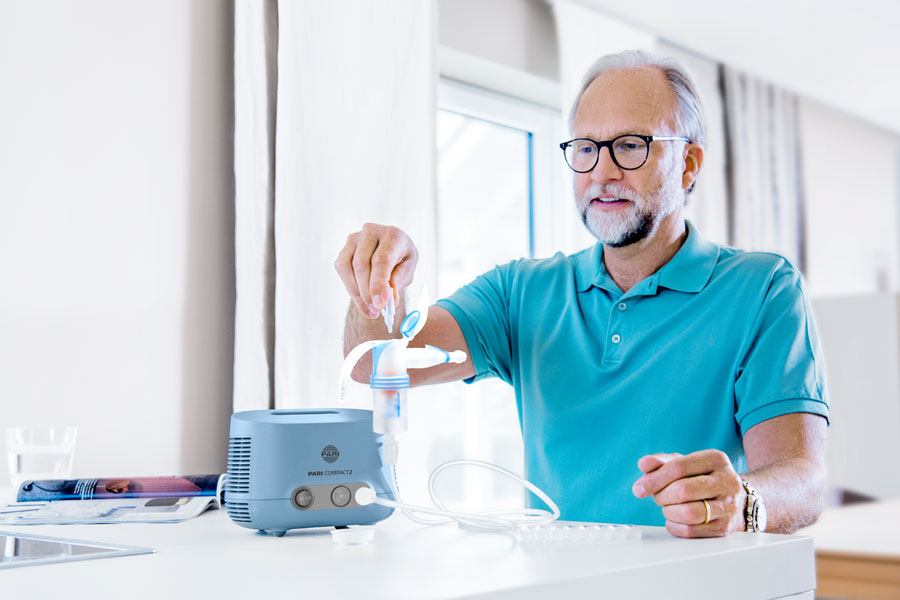High-quality nebulisers are versatile and suitable for administering saline solutions, as well as medicines, directly to the airways. Nebulising saline is beneficial for various respiratory conditions. This page provides information to assist individuals in making informed decisions regarding saline nebulisation.

When nebulisers are filled with saline they turn it into a fine mist. By inhaling through the mouthpiece or mask of the nebuliser, the saline solution is delivered to the lungs. Saline solution can only be inhaled with a nebuliser. It is not possible to inhale saline using steam, e.g. over a saucepan, because the water evaporates and leaves the all-important salt in the pot. The extraction of sea salt by evaporation would otherwise not be possible.
Our airways have a kind of self-cleaning mechanism, which is called mucociliary clearance. When inhaled with a nebuliser, the fine mist generated from the saline solution is delivered directly to the airways. Depending on the kind of saline solution, this can have different benefits.
Isotonic saline solution has the same salt concentration as our body fluids & moisturises the mucosa of our airways. This supports the natural barrier against viruses and other undesirable substances.
Hypertonic saline solution has a higher salt concentration than our body fluids. If hypertonic saline solution, e.g. 3% salt, is inhaled, this dissolves the sticky mucus via “osmosis”. Osmosis in this case means that the higher salt concentration makes water move from the cell into the mucus. This makes it more fluid or less viscous and enables it to be coughed up more easily.
Nebuliser treatment with saline is commonly used for lung conditions that involve excess mucus in the airways (phlegm). This phlegm is often the cause of coughing, frequent chest infections, reduced lung function and breathlessness. Therefore, mucus clearance is an important treatment goal for a variety of respiratory diseases. Such as:
Isotonic saline is best used daily during the winter season if used for preventing airway infections. If you already have an airway infection it is best to nebulise isotonic saline two to three times a day.
Hypertonic saline is an effective and well-established option for mucus clearance. If you have been asked by a medical professional to use hypertonic saline, please stick to their recommendations. If you use it on your own for mucus clearance, you can use it two to four times a day.

Inhaling saline solution (hypertonic and isotonic) is generally safe and well tolerated. Nebulised isotonic saline doesn´t have any known side effects or interactions with other medicines. Hypertonic saline can lead to increased coughing, which is a desired outcome when used for mucus clearance. If you have a chronic condition such as asthma or are pregnant, please make sure to speak with a healthcare professional about inhaling hypertonic saline.
Isotonic saline is the best option for a dry cough. It moisturises the mucous membranes of the airways, which has a soothing effect. It supports the natural barrier of our airways and thus can be used to support our airways during the winter season.
For excess mucus in the airways (cough with phlegm) hypertonic saline is the best option as it helps to loosen the mucus which can then be coughed up.
A prescription is not necessary for saline nebuliser solutions. There are a few conditions for which it can be prescribed, but mostly it´s bought privately, especially if you want to use it for prevention or to improve symptoms of acute respiratory diseases.
Inhaling saline solution with a nebuliser is commonly used for a variety of acute and chronic (short and long term) airway conditions. There are no dedicated saline nebulisers, as most nebulisers are very versatile and can be used with a variety of medications. However, it is always advisable to use a high-quality nebuliser. Nebulised hypertonic saline is used for mucus clearance. Isotonic saline nebuliser solution is best used to soothe a dry cough or support the natural barrier of our airways.
Contact us
Any questions? You can reach us at this number:
01932 341122
© 2025 PARI GmbH Spezialisten für effektive Inhalation